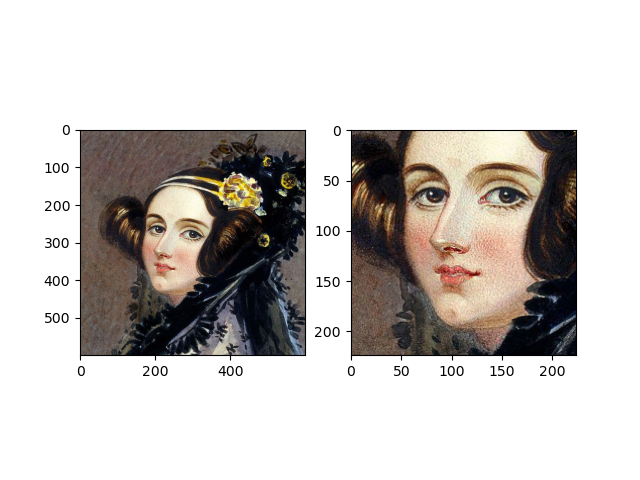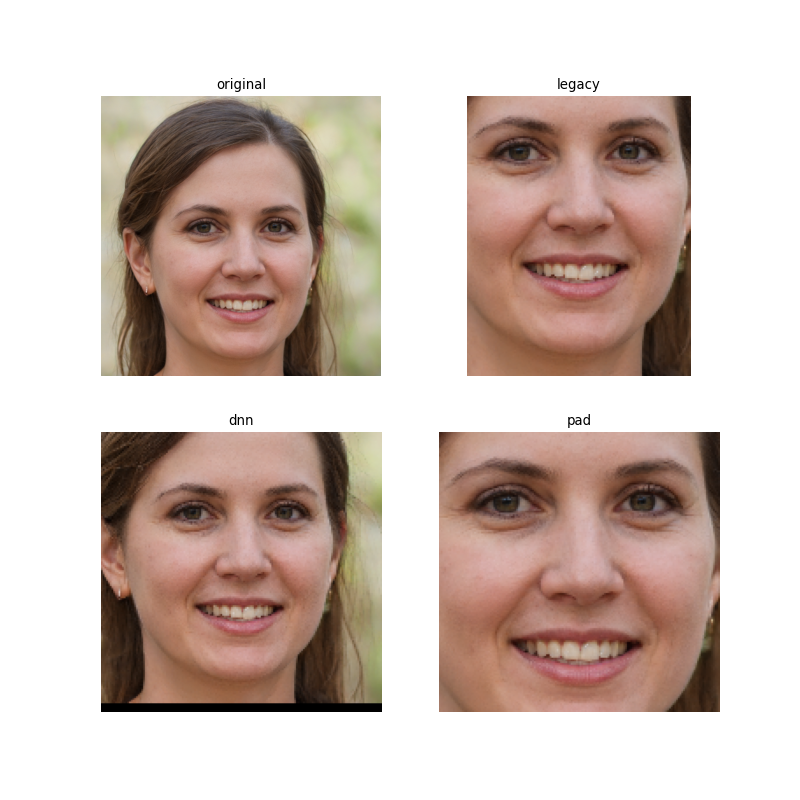FAQ¶
How to crop a face ?¶
The recipe below helps you to set a face cropper based on eye positions.
# ---
# jupyter:
# jupytext:
# formats: ipynb,py:light
# text_representation:
# extension: .py
# format_name: light
# format_version: '1.5'
# jupytext_version: 1.11.1
# kernelspec:
# display_name: Python 3
# language: python
# name: python3
# ---
# # How to crop a face
# +
import bob.bio.face
import bob.io.image
# Loading Ada's images
image = bob.io.base.load("./img/838_ada.jpg")
# Setting Ada's eyes
annotations = dict()
annotations["reye"] = (265, 203)
annotations["leye"] = (278, 294)
# Final cropped size
cropped_image_size = (224, 224)
# Defining where we want the eyes to be located after the crop
cropped_positions = {"leye": (65, 150), "reye": (65, 77)}
face_cropper = bob.bio.face.preprocessor.FaceCrop(
cropped_image_size=cropped_image_size,
cropped_positions=cropped_positions,
color_channel="rgb",
)
# Crops always a batch of images
cropped_image = face_cropper.transform([image], annotations=[annotations])
# +
# %matplotlib widget
import matplotlib.pyplot as plt
figure = plt.figure()
plt.subplot(121)
bob.io.image.imshow(image)
plt.subplot(122)
bob.io.image.imshow(cropped_image[0].astype("uint8"))
figure.show()
# -

How to choose the cropped positions ?¶
The ideal cropped positions are dependent on the specific application you are using the face cropper in. Some face embedding extractors work well on loosely cropped faces, while others require the face to be tightly cropped. We provide a few reasonable defaults that are used in our implemented baselines. They are accessible through a function as follows :
from bob.bio.face.utils import get_default_cropped_positions
mode = 'legacy'
cropped_image_size=(160, 160)
annotation_type='eyes-center'
cropped_positions = get_default_cropped_positions(mode, cropped_image_size, annotation_type)
There are currently three available modes :
legacyTight crop, used in non neural-net baselines such asgabor-graph,lgbphs. It is typically use with a 5:4 aspect ratio for thecropped_image_sizednnLoose crop, used for neural-net baselines such as the ArcFace or FaceNet models.padTight crop used in some PAD baselines
We present hereafter a visual example of those crops for the eyes-center annotation type.
import matplotlib.pyplot as plt
import bob.io.image
from bob.bio.face.preprocessor import FaceCrop
from bob.bio.face.utils import get_default_cropped_positions
src = bob.io.base.load("../img/cropping_example_source.png")
modes = ["legacy", "dnn", "pad"]
cropped_images = []
SIZE = 160
# Pick cropping mode
for mode in modes:
if mode == "legacy":
cropped_image_size = (SIZE, 4 * SIZE // 5)
else:
cropped_image_size = (SIZE, SIZE)
annotation_type = "eyes-center"
# Load default cropped positions
cropped_positions = get_default_cropped_positions(
mode, cropped_image_size, annotation_type
)
# Instanciate cropper and crop
cropper = FaceCrop(
cropped_image_size=cropped_image_size,
cropped_positions=cropped_positions,
fixed_positions={"reye": (480, 380), "leye": (480, 650)},
color_channel="rgb",
)
cropped_images.append(cropper.transform([src])[0].astype("uint8"))
# Visualize cropped images
fig, axes = plt.subplots(2, 2, figsize=(10, 10))
for i, (img, label) in enumerate(
zip([src] + cropped_images, ["original"] + modes)
):
ax = axes[i // 2, i % 2]
ax.axis("off")
ax.imshow(bob.io.image.to_matplotlib(img))
ax.set_title(label)
(Source code, png, hires.png, pdf)
